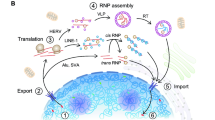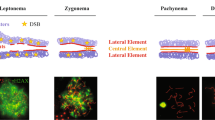Abstract
We have expressed an EGFP-CENP-A fusion protein in human cells in order to quantitate the level of CENP-A incorporated into normal and variant human centromeres. The results revealed a 3.2-fold difference in the level of CENP-A incorporation into α-satellite repeat DNA-based centromeres, with the Y centromere showing the lowest level of all normal human chromosomes. Identification of individual chromosomes revealed a statistically significant, though not absolute, correlation between chromosome size and CENP-A incorporation. Analysis of three independent neocentromeres revealed a significantly reduced level of CENP-A compared to normal centromeres. Truncation of a neocentric marker chromosome to produce a minichromosome further reduced CENP-A levels, indicating a remodelling of centromeric chromatin. These results suggest a role for increased CENP-A incorporation in the faithful segregation of larger chromosomes and support a model of centromere evolution in which neocentromeres represent ancestral centromeres that, through adaptive evolution, acquire satellite repeats to facilitate the incorporation of higher numbers of CENP-A containing nucleosomes, thereby facilitating the assembly of larger kinetochore structures.
Similar content being viewed by others
References
Alonso A, Mahmood R, Li S, Cheung F, Yoda K, Warburton PE (2003) Genomic microarray analysis reveals distinct locations for the CENP-A binding domains in three human chromosome 13q32 neocentromeres. Hum Mol Genet 12: 2711–2721.
Amor DJ, Choo KH (2002) Neocentromeres: role in human disease,evolution and centromere study. Am J Hum Genet 71: 695–714.
Ando S, Yang H, Nozaki N, Okazaki T, Yoda K (2002) CENP-A,-B,and -C chromatin complex that contains the I-type alpha-satellite array constitutes the prekinetochore in HeLa cells. Mol Cell Biol 22: 2229–2241.
Blower MD, Sullivan BA, Karpen GH (2002) Conserved organization of centromeric chromatin in flies and humans. Dev Cell 2: 319–330.
Brinkley BR, Valdivia MM, Tousson A, Brenner SL (1984) Compound kinetochores of the Indian muntjac. Evolution by linear fusion of unit kinetochores. Chromosoma 91: 1–11.
Cherry LM, Johnston DA (1987) Size variation in kinetochores of human chromosomes. Hum Genet 75: 155–158.
Cherry LM, Faulkner AJ, Grossberg LA, Balczon R (1989) Kinetochore size variation in mammalian chromosomes: an image analysis study with evolutionary implications. J Cell Sci 92 (Pt 2): 281–289.
Choo KH (1997) The Centromere. Oxford University Press, New York, Tokyo.
Craig JM, Earle E, Canham P, Wong LH, Anderson M, Choo KH (2003) Analysis of mammalian proteins involved in chromatin modification reveals new metaphase centromeric proteins and distinct chromosomal distribution patterns. Hum Mol Genet 12: 3109–3121.
Dytham C (2003) Choosing and Using Statistics. A Biologists Guide. Blackwell Publishing, Malden, Oxford, Melbourne, Berlin.
Earnshaw WC, Ratrie H, 3rd, Stetten G (1989) Visualization of centromere proteins CENP-B and CENP-C on a stable dicentric chromosome in cytological spreads. Chromosoma 98: 1–12.
Fantes JA, Green DK, Malloy P, Sumner AT (1989) Flow cytometry measurements of human chromosome kinetochore labeling. Cytometry 10: 134–142.
Floridia G, Zatterale A, Zuffardi O, Tyler-Smith C (2000) Mapping of a human centromere onto the DNA by topoisomerase II cleavage. EMBO Rep 1: 489–493.
Hudson DF, Fowler KJ, Earle E et al. (1998) Centromere protein B null mice are mitotically and meiotically normal but have lower body and testis weights. J Cell Biol 141: 309–319.
Kalitsis P, Fowler KJ, Earle E et al. (2003) Partially functional Cenpa-GFP fusion protein causes increased chromosome missegregation and apoptosis during mouse embryogenesis. Chromosome Res 11: 345–357.
Lo AWI, Craig JM, Saffery R et al. (2001a) A 330 kb CENP-A binding domain and altered replication timing at a human neocentromere. EMBO Journal 20: 2087–2096.
Lo AWI, Magliano DJ, Sibson NC, Kalitsis P, Craig JM, Choo KHA (2001b) A novel chromatin immunoprecipitation and array (CIA) analysis identifies a 460-kb CENP-A binding neocentromere DNA. Genome Research 11: 448–457.
Maggert KA, Karpen GH (2001) The activation of a neocentromere in Drosophila requires proximity to an endogenous centromere. Genetics 158: 1615–1628.
McEwen BF, Ding Y, Heagle AB (1998) Relevance of kinetochore size and microtubule-binding capacity for stable chromosome attachment during mitosis in PtKl cells. Chromosome Res 6: 123–132.
Nagaki K, Cheng Z, Ouyang S et al. (2004) Sequencing of a rice centromere uncovers active genes. Nat Genet 36: 138–145.
Nath J, Tucker JD, Hando JC (1995) Y chromosome aneuploidy, micronuclei, kinetochores and aging in men. Chromosoma 103: 725–731.
Ohzeki J, Nakano M, Okada T, Masumoto H (2002) CENP-B box is required for de novo centromere chromatin assembly on human alphoid DNA. J Cell Biol 159: 765–775.
Palmer DK, O’Day K, Wener MH, Andrews BS, Margolis RL (1987) A 17-kD centromere protein (CENP-A)copurifies with nucleosome core particles and with histones. J Cell Biol 104: 805–815.
Pedeutour F,Forus A, Coindre JM et al. (1999) Structure of the supernumerary ring and giant rod chromosomes in adipose tissue tumors. Genes Chromosomes Cancer 24: 30–41.
Peretti D, Maraschio P, Lambiase S, Lo Curto F, Zuffardi O (1986) Indirect immunofluorescence of inactive centromeres as indicator of centromeric function. Hum Genet 73: 12–16.
Perry J, Slater H, Choo KHA (2004) Centric fission-simple and complex mechanisms. Chromosome Res (in press)
Rivera H, Vassquez AI, Ayala-Madrigal ML, Ramirez-Duenas ML, Davalos IP (1996) Alphoidless centromere of a familial unstable inverted Y chromosome. Ann Genet 39: 236–239.
Saffery R, Irvine DV, Griffiths B, Kalitsis P, Wordeman L, Choo KH (2000) Human centromeres and neocentromeres show identical distribution patterns of >20 functionally important kinetochore-associated proteins. Hum Mol Genet 9: 175–185.
Saffery R, Wong LH, Irvine DV et al. (2001) Construction of neocentromere-based human minichromosomes by telomere-associated chromosomal truncation. Proc Natl Acad Sci USA 98: 5705–5710.
Schmitz A, Guilly MN, Trask B, van den Engh G (1992) Immunofluorescent labeling of centromeres for flow cytometric analysis. Cytometry 13: 478–484.
Schueler MG, Higgins AW, Rudd MK, Gustashaw K, Willard HF (2001) Genomic and genetic definition of a functional human centromere. Science 294: 109–115.
Shelby RD, Vafa O, Sullivan KF (1997) Assembly of CENP-A into centromeric chromatin requires a cooperative array of nucleosomal DNA contact sites. J Cell Biol 136: 501–513.
Spence JM, Critcher R, Ebersole TH et al. (2002) Colocalisation of centromere activity, proteins and topoisomerase II within a subdomain of the major human X a-satellite array. EMBO J 21: 5269–5280.
Sugimoto K, Fukuda R, Himeno M (2000) Centromere/kinetochore localization of human centromere protein A (CENP-A) exogenously expressed as a fusion to green fluorescent protein. Cell Struct Funct 25: 253–261.
Sullivan KF, Hechenberger M, Masri K (1994) Human CENP-A contains a histone H3 related histone fold domain that is required for targeting to the centromere. J Cell Biol 127: 581–592.
Suzuki N, Nakano M, Nozaki N, Egashira S, Okazaki T, Masumoto H (2004) CENP-B interacts with CENP-C domains containing Mif2 regions responsible for centromere localization. J Biol Chem 279: 5934–5946.
Tyler-Smith C, Oakey RJ, Larin Z et al. (1993) Localization of DNA sequences required for human centromere function through an analysis of rearranged Y chromosomes. Nat Genet 5: 368–375.
Van Hooser AA, Ouspenski II, Gregson HC et al. (2001) Specification of kinetochore-forming chromatin by the histone H3 variant CENP-A. J Cell Sci 114: 3529–3542.
Ventura M, Archidiacono N, Rocchi M (2001) Centromere emergence in evolution. Genome Res 11: 595–599.
Voullaire LE, Slater HR, Petrovic V, Choo KH (1993) A functional marker centromere with no detectable alpha-satellite, satellite III, or CENP-B protein: activation of a latent centromere? Am J Hum Genet 52: 1153–1163.
Voullaire L, Saffery R, Davies J et al. (1999) Trisomy 20p resulting from inverted duplication and neocentromere formation. Am J Med Genet 85: 403–408.
Warburton PE, Cooke CA, Bourassa, S et al. (1997) Immunolocalization of CENP-A suggests a distinct nucleosome structure at the inner kinetochore plate of active centromeres. Curr Biol 7: 901–904.
Wieland, G, Orthaus S, Ohndorf S, Diekmann S, Hemmerich P (2004) Functional complementation of human centromere protein A (CENP-A)by Cse4p from Saccharomyces cerevisiae. Mol Cell Biol 24: 6620–6630.
Yoda K, Ando S, Morishita S et al. (2000) Human centromere protein A (CENP-A)can replace histone H3 in nucleosome reconstitution in vitro. Proc Natl Acad Sci USA 97: 7266–7271.
Zinkowski RP, Meyne J, Brinkley BR (1991) The centromere-kinetochore complex: a repeat subunit model. J Cell Biol 113: 1091–1110.
Author information
Authors and Affiliations
Corresponding author
Rights and permissions
About this article
Cite this article
Irvine, D.V., Amor, D.J., Perry, J. et al. Chromosome size and origin as determinants of the level of CENP-A incorporation into human centromeres. Chromosome Res 12, 805–815 (2004). https://doi.org/10.1007/s10577-005-5377-4
Received:
Accepted:
Issue Date:
DOI: https://doi.org/10.1007/s10577-005-5377-4




